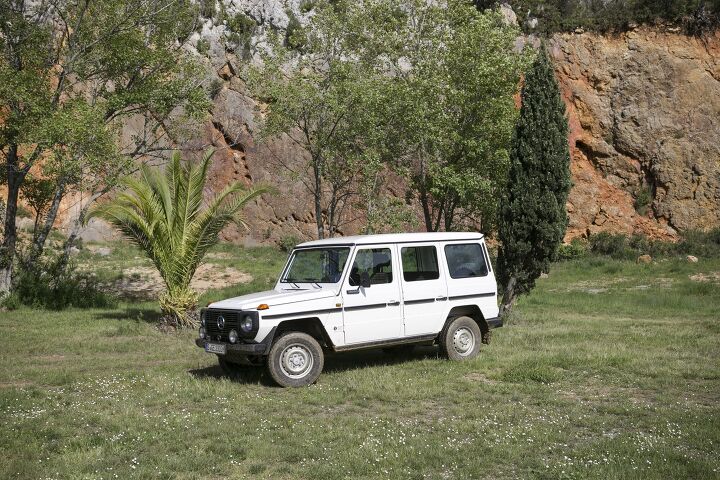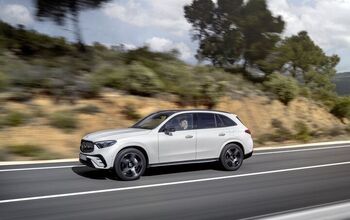2019 Mercedes-Benz G-Class Review

The sensation of opening – and shutting – the door on a Mercedes G-Class is an impressive experience, unique in the automotive realm.
There’s a heft to the door, just as there is with every other Mercedes product, but the actuation of the thumb button and hauling on a handle that feels as if it’s honed from granite conveys a sense of timeless precision and robust over-engineering not typically found in modern machinery. It’s not gentle, it’s not dainty. There’s no electronic assistance, and closing the door requires a proper slam.
It’s an exceptionally mechanical sensation, and that’s important because being mechanical in an increasingly digital age is what truly sets the G-Class – even this new one – apart from its competitors.
The new G 550 and AMG G 63 are, of course, loaded up with contemporary digital wizardry, like adaptive cruise control, lane-keeping assist and even active parking assistance, and the digitally-adjustable drive modes and suspension are particularly impressive in their operation on the G 63.FAST FACTS
| Engine: | 4.0-liter Twin Turbo V8 |
| Output: | 416 hp, 450 lb-ft of torque (G 550), 577 hp, 627 lb-ft of torque (G 63) |
| Transmission: | 9-Speed Auto |
| 0-62 MPH (100 km/h): | 5.9 seconds (G 550) 4.5 seconds (G 63) |
| Towing Capacity: | 7,700 lbs (G 550) |
| Fuel Economy: | TBD |
| Price: | TBD |
But the fundamentals of what has always made a G-wagen what it is – rugged durability that’ll survive apocalyptic conditions, built upon an unapologetically industrial ladder frame – give this new Mercedes its age-old character. When the Geländewagen (off-road vehicle) was first conceived in the 1970s, it was for professional applications like contractor trucks, military machines and even the Popemobile, not the passenger car market. Short of a Jeep Wrangler, there aren’t any other modern sport utilities that feel so closely tied to their working past, yet so dramatically refined.
ALSO SEE: Where is Mercedes Made?
The Graz, Austria plant began producing the first evolution of today’s G-Class in 1979, and to this day, production continues exclusively at this facility – almost entirely by-hand – situated near the Schöckl mountain that’s used to develop and abuse every iteration of the brand’s storied off-roader.
Following in The Same Tire Tracks
We were given the opportunity to drive the G 550 and G 63 at the Château de Lastours in Southern France. This location is significant not only historically (it’s where the last generation G-Class was also introduced to the media 18 years ago), but due to the fact that the 700-hectare winery serves double-duty as a challenging proving ground for off-road driving and even World Rally Car testing. Climbing up and down the mountainous terrain, it’s easy to believe the brand’s claim that the new G-wagen is superior to its predecessor when the roads disappear.
A proper low-range can be switched on-the-fly up to 40 km/h with a ratio change from high range at 1.00 to 2.93 in low. This is nearly 1/3 shorter than before giving the new G a highly functional craw speed for inclines and declines, requiring no electronic braking that’s employed by some competitors to achieve the same results.
Likewise, the new G-Class is the only production vehicle available with three electronically-actuated locking differentials. When locked, the center diff sends 50% of the power both fore and aft (as opposed to a 40/60 split when “unlocked”). Each the rear and front differentials can be locked individually on-the-go as well, at the push of a button. The G-Class utilizes a full-time all-wheel-drive system.
The result is uncompromised traction, unlike many competitors’ electronic systems that activate only upon slip detection, potentially upsetting the machine in a precarious state. This makes for incredible climbing, even on the loose rock and gravel hills we experienced. Ground clearance (24.1 cm between axles), approach (31) and departure (30) angles are all improved, and a tilt angle of 35 is also an improvement; an experience we put to the test during our drive.
Fording depth is also increased by 10 cm to 70 cm thanks to engineering like protective foil cladding on the side and rear doors that prevent water from penetrating the cabin. Having submerged the entire 3-pointed star on the grille while crossing a water hole, we can confirm this capability as well.
The Falken Wildpeak all-terrain tires fitted to our off-road testers can be specified when ordering a new G-Class and held up exceptionally well over the sharp rocks and gravel, as well as maintaining their on-road manners, only showing any significant limitations in mud.
And then there’s the AMG
Despite more asphalt-oriented tires (on larger wheels), and the wildly bad-ass side pipes limiting clearance, the AMG G 63 still makes use of the hardware that makes the G 550 such a mountain goat. Locking diffs, low range and significant suspension articulation conspire to take G 63 drivers much further off the beaten-path than other pricey, sport-oriented SUVs.
Where the AMG also differs is with its DYNAMIC SELECT control that offers not only Slippery, Comfort, Sport and Sport+ modes like other AMG models, but also off-road settings for Sand, Trail and Rock conditions. A mud, rock and gravel circuit was set up wherein we were encouraged to drive the G 63 as if it were a rally car at speeds high enough to drift the tail-end out in the corners, spewing mud and rocks into the French hinterland. The different drive modes adjust the characteristics of suspension stiffness, throttle response and shift points, optimized for traction and performance over the varying conditions.
Interior Details
Truthfully, we’re not fully convinced the new G-wagen are any more adept off-road than a similarly-sized Jeep Wrangler costing a fraction as much as the Mercedes. But being a Mercedes means the G can also suitably coddle its occupants whether on- or off-road too. Heated massaging seats and the 15-speaker Burmester audio system are lavish treats when committing acts of mechanical cruelty bounding over rocks.
Plus, the occupants now enjoy more space inside with elbow, shoulder and legroom growing considerably, especially in the rear with an additional 6 inches (15 cm) available!
Under the Hood
What’s more impressive is that no machine as capable off-road as the G-wagen should be able to accelerate from rest to 60 mph in less than 4.5 seconds, the way the G 63 can (G 550 is said to do it in less than 6 seconds). With 577 hp and 627 lb-ft of torque on hand from the G 63, and 416 hp and 450 lb-ft from the G 550, the robust power delivery and smooth and linear throughout the rev range. Plus, the new 9-speed automatic does a great job suiting each of the G’s personalities, whether on-road cruising with smooth shifts, hustling with quick ones during aggressive driving, or whatever is required when off-road.
Power is one thing, but controlling a vehicle that resembles a top-hat-on-wheels during cornering maneuvers is something altogether different. The G 63 tackled the circuitous French secondary roads with speeds that suggest Mercedes’ engineers have found a way to cheat physics. Getting used to such a large (by European standards) and a tall seating position that exaggerates the sensation of body roll takes some time, but the new double-wishbone front suspension is now aided by torsion-bar stabilizer that’s nearly as thick as a bridge trestle. The fact that the G-wagen still uses a rigid rear axle makes this thing’s on-road capabilities all the more impressive.
Even the electromechanical rack-and-pinion steering has impressive and direct feel for such a rugged machine, especially in the Sport and Sport+ settings. Several early generation G-wagens were made available to us as well, including a funky little fire truck. Nowhere were the on-road improvements more obvious than by comparing it to the slow, utilitarian driving experience of the old Gs.
If there’s one complaint, it’s that the G-Class exhibits a startling amount of wind noise in the cabin for a luxury vehicle, despite Mercedes’ spokespeople claiming a notable reduction. Driving a vehicle with the aerodynamic properties of a washing machine is bound to have that trade-off. And aside from the cost and fuel consumption (both of which are expected to be high, but not yet confirmed), there’s little else to whine about here.
Alas, nearly all of the engineering miracles that enable the G-Class to achieve such greatness both on-road and off will be completely lost on all but a small fraction of buyers. Instead, most of the wealthy, fortunate folks who order a G-wagen will do so because of its lavish interior, or they’ll simply love it for its iconic profile and attention-commanding exclusivity.
The Verdict: 2019 Mercedes-Benz G-Class Review
The new Mercedes and AMG G-Class rigs are remarkable machines, dynamically superior than their already impressive processors, and yet so few buyers will ever take the chance to truly appreciate these capabilities, being content in the luxury and image-boosting qualities. But even if all of the engineering improvements go largely unnoticed, opening and closing those doors every time a buyer climbs into his or her G-Class will remind just how unique and special a machine this is.
Official pricing and fuel economy figures will be available closer to the G-Class’s availability in dealerships this summer.

If there’s anything better than a good road trip through the desert, Jeff probably hasn’t heard of it. He’s got a propensity for buying less-than-perfect sports cars like a well-worn Boxster, an M Roadster and an MR2, but has applied a lifetime of passion to more than a dozen years of automotive and motorcycle reviews. He’s even collected several awards in the process including recognition for Best Automotive Review and Best Published Photography from the Automobile Journalists of Canada in 2023.
More by Jeff Wilson













































































Comments
Join the conversation
Best SUV of all time
I didn't even have to read it to know I love it. I wish the MB G-Class and Toyota Land Cruiser had non-luxury versions around $50k, if VW and Volvo can make plaid interiors cool then more modest versions of the G-Class and Land Cruiser would sell. I guess that's what Wranglers and 4Runners are for.